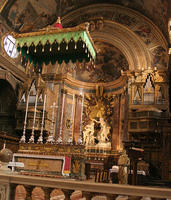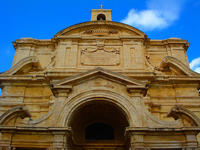You are in: Europe -> Malta -> City of Valletta, and traditional search or Image Gallery will yield results of this site only
City of Valletta
| Site number: | 131 |
|
| Type of site: | Cultural | |
| Date: | - | |
| Date of Inscription: | 1980 | |
| Location: | Europe, Malta, Island of Malta | |
Up to 75 images are shown here. Click on each for more details or on Image Gallery for more images.
| Description: | The City of Valletta, as the capital of Malta is indistinguishably connected to the Order of St John of Jerusalem’s history of military and charitable activities. In turn it was governed by the Phoenicians, Greeks, Carthaginians, Romans, Byzantines, Arabs and the Order of the Knights of St John. Valletta is one of the world’s most concentrated historic areas as its 55 ha area contains all of its 320 monuments. --WHMNet paraphrase from the description at WHC Site, where additional information is available. | |
| Valletta, population 6,315 (official estimate for 2005), is the capital city of Malta. The whole city was inscribed as a UNESCO World Heritage Site in 1980. The foundation stone of Valletta was laid by the Grandmaster of the Order of Saint John, Jean Parisot de la Valette, on 28 March 1566; The Order (which was the long-time ruler of the city and the island) decided to found a new city on the Xiberras peninsula just after the end of the Siege of Malta in 1565, so as to fortify the Order's position in Malta, effectively binding the Knights to the island. The city was designed by Francesco Laparelli, while many of the most important buildings were built by Gerolamo Cassar. Valletta, hence, is an urban area which boasts many buildings from the 16th century and onwards, but most of them were built during the time of the Knights of St. John of Jerusalem (the Knights Hospitaller, or Knights of Malta). On 28 March 1566, the building of the city was inaugurated, with La Valette himself placing the first stone, where there is now the Church of Our Lady of Victories. The city's plan was somewhat new to the Maltese Islands, as while other towns and cities had irregular winding streets and alleys, the new city had a rectangular design, without any Collacchio, that is an area restricted for important buildings. The streets were to be wide and straight, with the one in the middle starting from the City Gate and ending up at Fort Saint Elmo on the other end. Some of the bastions were to be 153 feet tall. Unfortunately, La Valette never saw the completion of the city, as he died on 21 August 1568, aged 74. He was buried in the church of Our Lady of the Victories, but after the St. John's Co-Cathedral was built, his remains were taken there. His tomb is now surrounded by those of the rest of the Grand Masters. After the Knights and the brief French interlude, the next building boom in Valletta occurred during the British rule. Gates were widened, buildings demolished and rebuilt, houses widened and civic projects installed; however, the whole city and its infrastructure were damaged by air raids in World War II, notably losing its majestic opera house constructed at the city entrance in the 19th century. --Wikipedia. Text is available under the Creative Commons Attribution-ShareAlike License. | ||
| Source: | http://whc.unesco.org/en/list/131 | |
| Reference: | 1. UNESCO World Heritage Center, Site Page. | |





























